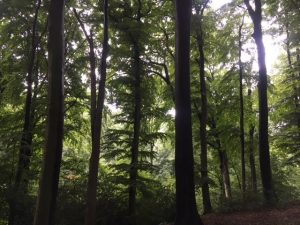Forest Bathing For All Seasons
June is when the spring frenzy is on in the forest. All that crazy singing, growing, blooming, mating, food searching and reproducing. By late July, the frenzy has stopped and given way to a relaxed and sated atmosphere in the woods. The race is over.
In summer, birds no longer fight over territories, mates, and food, but hang out together in loose bands; molting and eating their fill on an abundance of berries, seeds and caterpillars.
In the forest, plants stop trying to outgrow each other in competition for sunlight, and instead set seeds and store energy in their tissues. Oak trees are pregnant with acorns, filbert hedges heavy with hazelnuts and wild roses laden with sweet rose hips. It’s a most relaxing and rewarding time to take to the woods. One is reminded of the vast mycelium underfoot by delicious mushrooms that spring up overnight.
In fall, everything comes to fruition. One knows it is truly fall when the songbirds, inspired by similar day lengths and temperatures as in spring, begin a brief and subtle period of singing, which is quickly silenced by longer nights and colder temperatures.
In winter, the forest rests, hibernates, and bugs overwinter, storms prompt tree roots to grow strong and resilient. Winter is thought of as dead and still, yet for many trees it is a time of preparation, rejuvenation and rest. Though the trees appear motionless to us, there is a steady flow of sap in the trunks. The strongest sap flow occurs in late winter, when the nights are still freezing. With better hearing we could listen to rivers of sap flowing and disturbing the silence of the winter forest.
All the seasons are perfect for a walk in the forest to “take a bath.” The concept of forest bathing is Japanese. They call it “Shinrin-yoku.” It means “taking in the forest atmosphere” and is a medicinal infusion of nature when escaping from the noisy world we inhabit. To take this bath, walk silently through the woods and listen to birds, feel trees and plants, sit and meditate or just breathe in the aroma of the forest. It is important to be silent so you can hear the wind in the trees or water running in a creek. It is amazing what goes on in the wilderness when you stop to listen.
John Muir wrote, “Thousands of tired, nerve-shaken, over-civilized people are beginning to find out that going to the mountains is going home. Wilderness is a necessity.” We are lucky to be living in the Sierra Nevada with forest all around us. We just need to stop and take it in. The smells, the textures, the sounds actually help us relax and de-stress. For people living in big cities, parks and open spaces will also provide a respite from the noise of busy streets.
Public health studies in Japan have shown that forest bathing lowers blood pressure in some people, helps the immune system and lowers stress. The psychological effects of forest bathing are very healthful. In a meditation group in Oakland, one of the members said, after 15 minutes of silent meditation, she never noticed that Oakland had so many birds.
No matter what season you choose to take a bath in the forest, there is so much going on that we never notice unless we are mindful and silent.
Sabine Höppner is a professional gardener in Los Angeles and her company, Water’s Edge Gardening, specializes in native plants and drought-tolerant gardens.
Francie McGowan is a University of California Cooperative Extension Master Gardener of Tuolumne County.
UCCE Master Gardeners of Tuolumne County can answer home gardening questions. Call 209-533-5912 or go to: http://ucanr.edu/survey/survey.cfm?surveynumber=7269 to fill out our easy-to-use problem questionnaire. Check out our website at: http://cecentralsierra.ucanr.edu/Master_Gardeners/ You can also find us on Facebook.

